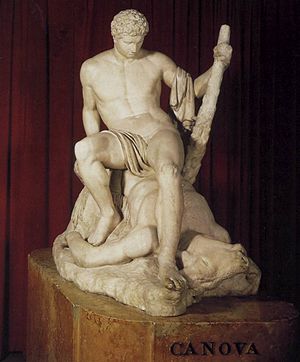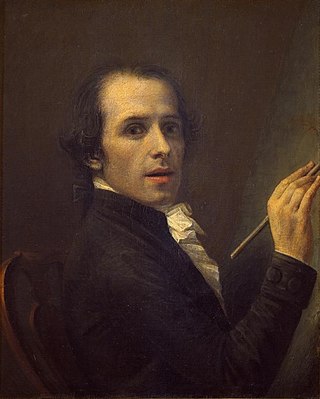
Antonio Canova was an Italian Neoclassical sculptor, famous for his marble sculptures. Often regarded as the greatest of the Neoclassical artists, his sculpture was inspired by the Baroque and the classical revival, and has been characterised as having avoided the melodramatics of the former, and the cold artificiality of the latter.

The Galleria Borghese is an art gallery in Rome, Italy, housed in the former Villa Borghese Pinciana. At the outset, the gallery building was integrated with its gardens, but nowadays the Villa Borghese gardens are considered a separate tourist attraction. The Galleria Borghese houses a substantial part of the Borghese Collection of paintings, sculpture and antiquities, begun by Cardinal Scipione Borghese, the nephew of Pope Paul V. The building was constructed by the architect Flaminio Ponzio, developing sketches by Scipione Borghese himself, who used it as a villa suburbana, a country villa at the edge of Rome.
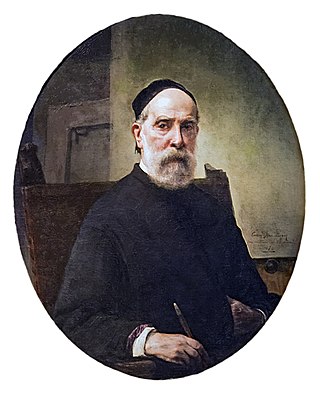
Francesco Hayez was an Italian painter. He is considered one of the leading artists of Romanticism in mid-19th-century Milan, and is renowned for his grand historical paintings, political allegories, and portraits.
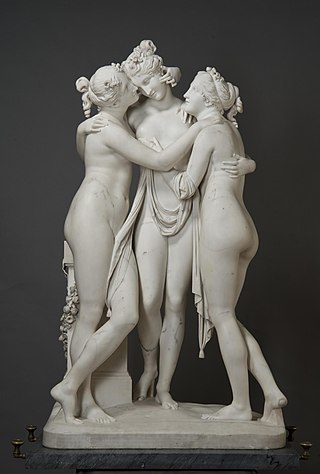
Antonio Canova's statue The Three Graces is a Neoclassical sculpture, in marble, of the mythological three Charites, daughters of Zeus – identified on some engravings of the statue as, from left to right, Euphrosyne, Aglaea and Thalia – who were said to represent youth/beauty (Thalia), mirth (Euphrosyne), and elegance (Aglaea). The Graces presided over banquets and gatherings, to delight the guests of the gods. As such they have served as subjects for historical artists including Sandro Botticelli and Bertel Thorvaldsen. A version of the sculpture is in the Hermitage Museum, and another is owned jointly and exhibited in turn by the Victoria and Albert Museum and the Scottish National Gallery.

Carlo Marchionni was an Italian architect. He was also a sculptor and a virtuoso draughtsman, who mixed in the artistic and intellectual circles. He was born and died in Rome.

The Tempio Malatestiano is the unfinished cathedral church of Rimini, Italy. Officially named for St. Francis, it takes the popular name from Sigismondo Pandolfo Malatesta, who commissioned its reconstruction by the famous Renaissance theorist and architect Leon Battista Alberti around 1450.
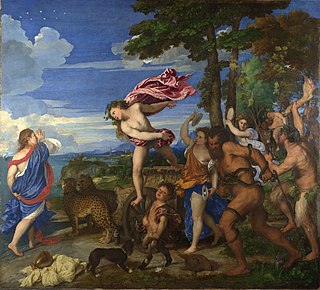
L'Arianna is the lost second opera by Italian composer Claudio Monteverdi. One of the earliest operas in general, it was composed in 1607–1608 and first performed on 28 May 1608, as part of the musical festivities for a royal wedding at the court of Duke Vincenzo Gonzaga in Mantua. All the music is lost apart from the extended recitative known as "Lamento d'Arianna". The libretto, which survives complete, was written in eight scenes by Ottavio Rinuccini, who used Ovid's Heroides and other classical sources to relate the story of Ariadne's abandonment by Theseus on the island of Naxos and her subsequent elevation as bride to the god Bacchus.
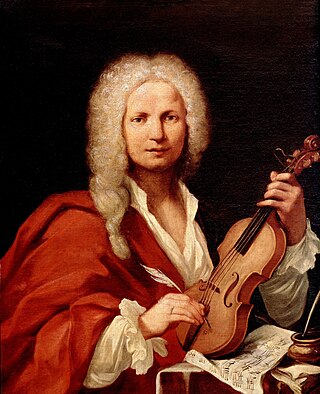
Ercole su'l Termodonte is a baroque Italian opera in three acts. In 1723, it became the sixteenth opera set to music by Antonio Vivaldi. Its catalogue number is RV 710. The libretto was written by Antonio Salvi. The opera was premiered on 23 January 1723 in Rome's Teatro Capranica. Due to a papal edict preventing women from appearing onstage in Rome, it premiered with castrati singing all the female roles. Vivaldi was both conductor and violin soloist.
The Pinacoteca Civica of Forlì, one of the civic museums of Forlì and currently based in the Musei di San Domenico, is an Italian art gallery. Artists whose work the gallery exhibits include:

Napoleon as Mars the Peacemaker is a colossal heroic nude statue by the Italian artist Antonio Canova, of Napoleon I of France in the guise of the Roman god Mars. He holds a gilded Nike or Victory standing on an orb in his right hand and a staff in his left. It was produced between 1802 and 1806 and stands 3.45 metres to the raised left hand. Once on display in the Louvre in Paris, it was purchased from Louis XVIII in 1816 by the British government, which granted it to the Duke of Wellington. It is now on display in Robert Adam's stairwell at the Duke's London residence, Apsley House.

Minotaur, the Wild Beast of Crete is a 1960 film based on the Greek legend of Theseus, the Athenian hero who is said to have slain a minotaur on Minoan Crete around 1500 or 1450 BC. The film was directed by Silvio Amadio and starred Bob Mathias.

The Palazzo Bolognetti-Torlonia, today demolished, was a palace located in Piazza Venezia, Rome, Italy.
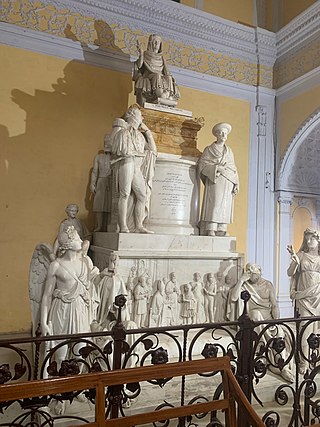
Adamo Tadolini was an Italian sculptor. One of a family of sculptors, he studied in Rome with the neo-classical sculptor Antonio Canova and is linked to him in style.
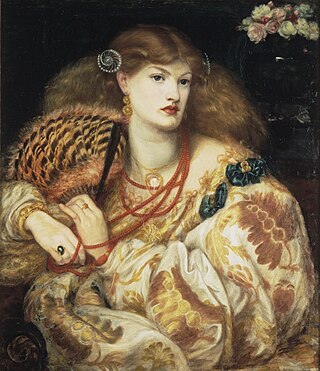
Monna Vanna is an 1866 oil on canvas painting by Dante Gabriel Rossetti. It was acquired by the collector William Henry Blackmore and later entered the collection of George Rae, one of Rossetti's patrons. It later passed from Rae to the joint ownership of Arthur Du Cros and Otto Beit and it was purchased from them by the Tate Gallery in 1916 via the NACF – it is now in the collection of Tate Britain in London.
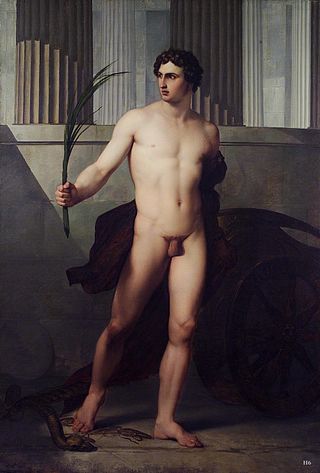
The Victorious Athlete or The Triumphant Athlete is an 1813 oil-on-canvas painting by the Italian artist Francesco Hayez, now in the Accademia di San Luca in Rome.
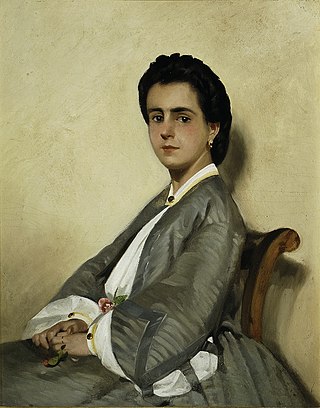
Cousin Argia is an 1861 oil on card painting by Giovanni Fattori, now in the Gallery of Modern Art in Florence. A label on the reverse is inscribed "Gio. Fattori alla sua cugina Argia. Anno 1861", but this may not be in the artist's own hand and no Argia is known in his family.

CavaliereGirolamo Zulian was a Venetian nobleman, ambassador, patron of the arts, art collector and Senatore Amplissimo. A member of the House of Zulian, he is best known for his leading art collection and for being one of the earliest patrons of Canova, a great friend of his, from whom he commissioned the Theseus and the Minotaur in 1781, while serving as ambassador to Rome. Zulian is credited as having played a fundamental role in Canova's rise to fame.

The Zulian family was an old Venetian noble family. The place from whence the Zulian came to Venice is unclear; however, the family is considered one of the first that moved to Venice, and thus one of the oldest Venetian and Italian noble families. The family produced tribunes, and in the early 8th century gained dukedom, as a family member rose to the position of Maestro dei cavalieri. The family produced several prominent Venetian figures, including statesmen, generals, patrons and magnates.
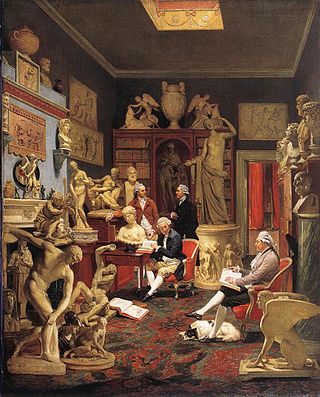
Charles Townley in His Sculpture Gallery, also known as Charles Townley at His Library at no. 7 Park Street in Westminster, is an oil-on-canvas painting by German British artist Johann Zoffany, made in 1782. It is held in the Towneley Hall Art Gallery and Museum, in Burnley.
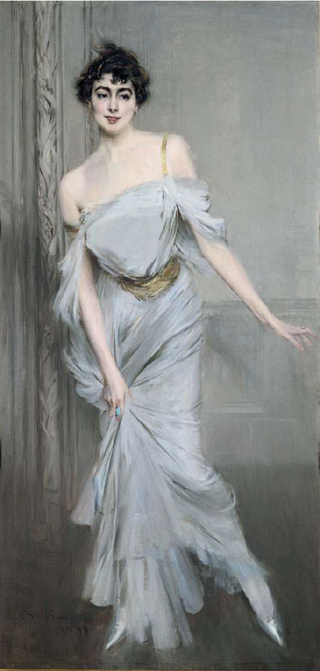
Madame Charles Max is an oil on canvas painting by the Italian painter Giovanni Boldini, from 1896. It is held in the Musée d'Orsay, in Paris.
